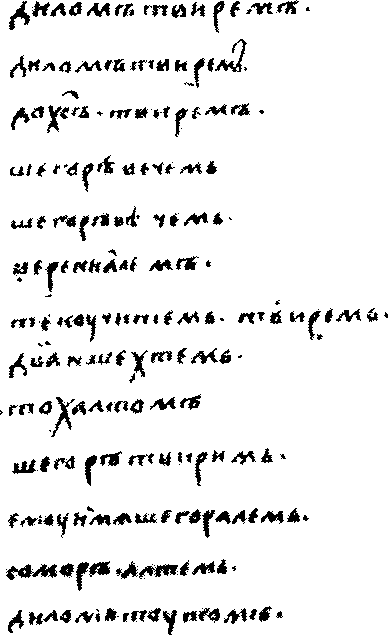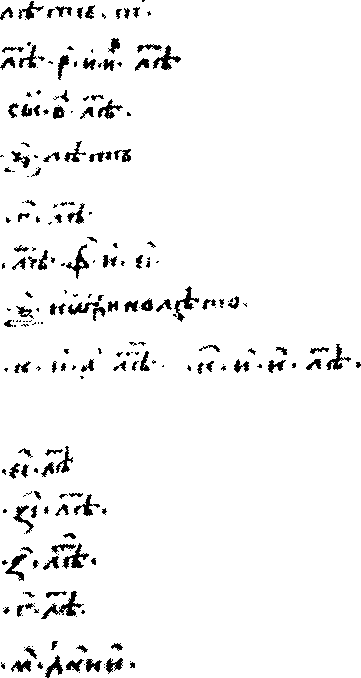|
Russian Version needs a translation |
Besenyos, Ogur and Oguz |
Alan Dateline |
|||||||||||||||||||||||||||||||||||||||||||||||||||||||||||||||||||||||||
|
Djagfar Tarihi Contents · Djagfar Tarihi Preface · Djagfar Tarihi Appendix |
|||||||||||||||||||||||||||||||||||||||||||||||||||||||||||||||||||||||||||
DANUBE BULGARIA KHAN'S LISTFragment |
|||||||||||||||||||||||||||||||||||||||||||||||||||||||||||||||||||||||||||
Links |
|||||||||||||||||||||||||||||||||||||||||||||||||||||||||||||||||||||||||||
|
http://members.tripod.com/~Groznijat/pb_lang/nominalia.html |
|||||||||||||||||||||||||||||||||||||||||||||||||||||||||||||||||||||||||||
Background |
|||||||||||||||||||||||||||||||||||||||||||||||||||||||||||||||||||||||||||
|
In 1861 a Russian scholar A. Popov discovered the document, known under names Imennik (Slavic "Namelist"), Kingslist, Khanslist, Fürstenliste and Nominalia, in a large collection of old Rus and Bulgarian historical texts entitled "Hellenic Chronicler", a rare and original historical relic. It exists in 3 manuscript copies. There are numerous variations and outright discrepancies between the copies and within the same manuscript. It is assumed that the document was composed during the reign of Khan Boyan, elected to the Khan position in ca. 763 or 767 AD, because the last on the list is a short reign of his predecessor Khan Umar. It represents the genealogy for 12 generations of the Bulgarian Khans, beginning with the most legendary Hunnish Khan Attila (b. 406, c. 437-453) and ending with the 8th c. Khan Umar. It is further supposed that the text was initially written on rock columns in the capital Pliska and later, after the Cyrillic alphabet was introduced to replace the Glagolic alphabet ca. 860 AD, or later in the 9th or 10th century, it was translated and transcribed. Pliska was the Danube Bulgarian capital from ca 681 to 893 AD, when Khan Shamgun (Simeon the Great) moved the capital to Bersula (Preslav). It contains the names of the rulers of Bulgarian dynasties - DULO and VOKIL. Against the names are given in Old Bulgarian accordingly the year of their ascension to the throne and the duration of their rule. Here is the complete text of "The Name List of Bulgarian Khans" inModern Bulgarian: compiled in the time of the founder of the Bulgarian state Khan Asparoukh (681 - about 700). Later continued, up to about , (Avitohol). The too long time of his rule, and that of his heir Ernich, was obviously of a legendary character It is a list of the rulers of Bulgaria, starting with the first two progenitors - Avitohol and Irnik, The Western Hun's Khans dynasty partial diagram is compiled primarily from the Djagfar Tarihi Annals, with no attempts to resolve the multitude of discrepancies contained in various accounts. Each of the parallel branches present a dynasty in itself. On this site can be found some details about all the rulers listed in the chart. For the listing of the dynasty, see WESTERN HUN'S KHAN DYNASTIES I am really excited, in the past I never looked closely at the original, and was taking on faith the readings of the experts. Now, I read it myself, and see a number of discrepancies in these readings. First, I could never understand why Atila is called Avitokhol. Did not make any sense. Now I clearly see Atila Khan as the first word, and you will see it too if you look at it. And he is sure Atila Khan. It is clearly visible even in the distorted rendering. Title follows the name, as in all Tьrkic titles. I will spare you the examples. Secondly, I never could trust the numbers read by the expers. Now I see that in a 12 year cycle (I think this is absolutely accepted by everybody) the number of years between cyclic years is not a multiple of 12, i.e. an impossibility. From Shegor to Shegor is either 12 or 24 etc, not 15 or 17. You can't trust the readings of the numbers. Unfortunately, I can't do it myself for the reason of my ignorance. Thirdly, for Tervel data is given twice, like a poor etching first time required a repeat confirmation, or a correction. You tried to read that as for a separate unnamed ruler, but it does not read so. Your explanation of the ou diphtong serving as a substitute for u, then excludes the necesity for a Greek intermediry, weather as a scribe or as the inscription, and tilts the concept that the translation was made directly from the Tьrkic original. The dots as separators, titles after the name, and the brevity of the inscription all tend to confirm it. Because of agglutination, the Tьrkic texts are very compact, 1/2 of Slavic and 2/3 of English. I have some more observations to that respect, but it would suffice for now. But there are fairly detailed arguments, advanced by Moskov among others, that the kinglist originated as an inscription in Greek and was later translated into Slavonic and rendered into Cyrillic. whether Vokil and Ukil are one and the same, since the two appear side by side in the same text. Some have argued that this is enough to deny the equation, yet just above them we have Isperih followed by Esperih (in one manuscript Espererih). I think the equation Vokil=Ukil is probably sound, for reasons detailed in the notes to the Imennik. |
|||||||||||||||||||||||||||||||||||||||||||||||||||||||||||||||||||||||||||
|
One of 3 Khanslist manuscripts |
|||||||||||||||||||||||||||||||||||||||||||||||||||||||||||||||||||||||||||
|
|
|||||||||||||||||||||||||||||||||||||||||||||||||||||||||||||||||||||||||||
|
Khanslist manuscript detail |
|||||||||||||||||||||||||||||||||||||||||||||||||||||||||||||||||||||||||||
|
|
 |
 |
|||||||||||||||||||||||||||||||||||||||||||||||||||||||||||||||||||||||||
In Cyrillic script |
|||||||||||||||||||||||||||||||||||||||||||||||||||||||||||||||||||||||||||
|
Question mark in parenthesis substitutes for undeciphered letter. Question mark following a letter indicates a possible interpretation of the letter. Horse (Tuki, Tuku etc.) and Sheep (Téké) are phonetically close and may be misinterpreted as written in the Imennik. |
|||||||||||||||||||||||||||||||||||||||||||||||||||||||||||||||||||||||||||
|
|
|
|||||||||||||||||||||||||||||||||||||||||||||||||||||||||||||||||||||||||
In Latin script |
|||||||||||||||||||||||||||||||||||||||||||||||||||||||||||||||||||||||||||
|
|
|
|||||||||||||||||||||||||||||||||||||||||||||||||||||||||||||||||||||||||
|
Bulgarian Türkic Calendar |
|||||||||||||||||||||||||||||||||||||||||||||||||||||||||||||||||||||||||||
|
The calendar presented here for illustration purposes only completes and corrects, using the published detailed description of the 12 year animal cycle Bulgarian calendar, the attempt to reconstruct the Bulgarian calendar posted in http://members.tripod.com/~Groznijat/pb_lang/pbl_3_1.html. Most of the calendar month-names have dialectal and historical variations, for a more complete listing of the terms click here. Naturally, the Danube Bulgars knew little about the "imeonshegor" name for a horse, reportedly widely used by the Pamirian Indoeuropeans up in the Himalayas, and had to use more familiar Türkic terminology. The shown month-names are those that seem to be closer to the months listed in the Bulgarian Khanslist. 12 year lunisolar animal cycle calendar does not have a sequential count of years like the Gregorain, its predecessors, and other solar calendars. To calculate in the Bulgarian 12-year cycle calendar the current year of a Gregorian calendar, deduct 3 from the last, then divide the result into 12. The remainder of the division will be a sequential number of the year in the Bulgarian cycle, and an exact division means the12-th year of a cycle.
|
|||||||||||||||||||||||||||||||||||||||||||||||||||||||||||||||||||||||||||
|
Bulgarian Cardinal and Ordinal Numbers |
|||||||||||||||||||||||||||||||||||||||||||||||||||||||||||||||||||||||||||
|
Source: Khanslist and http://www.zompist.com/asia.htm
In Türkic languages, "alem" is not a number, but an adjective with a meaning of "starting, initial, breakthrough" and the like. |
|||||||||||||||||||||||||||||||||||||||||||||||||||||||||||||||||||||||||||
|
Khanslist manuscript detail |
|||||||||||||||||||||||||||||||||||||||||||||||||||||||||||||||||||||||||||
|
M. Moskov, Imennik na bylgarskite hanove, Sofia, 1988) who worked along the turkic hypothesis. According to him the original text of the nominalia must have been written in greek and the present (slavic) text we have is a rather clumsy translation from greek. So he, first, reconstructed the 'original' greek text, |
|||||||||||||||||||||||||||||||||||||||||||||||||||||||||||||||||||||||||||
|
WESTERN HUN'S KHAN LINEAGE |
|||||||||||||||||||||||||||||||||||||||||||||||||||||||||||||||||||||||||||
|
|||||||||||||||||||||||||||||||||||||||||||||||||||||||||||||||||||||||||||
| I |
|
||||||||||||||||||||||||||||||||||||||||||||||||||||||||||||||||||||||||||
|
AVITOHOL lived 300 years. His family was Dulo. His year was DILOMTVIREM. IRNIK lived 150 years. His family was Dulo. His year was DILOM TVIREM. GOSTUN. He was a proxy. His family was Ermi. His year was DOKS TVIREM. KOURT held power for 60 years. His family was Dulo. His year was SHEGORVECHEM. BESMER, 3 years. His family was Dulo. His year was SHEGOR VECHEM. These princes ruled for 515 years on the other side of the Danube with shaved heads. Then came ISPERIH on this side of the Danube, as it is now. ISPERIH, 61 years. His family was Dulo. His year was VERENI ALEM. TERVEL, 21 years. His family was Dulo. His year was TEKU CHITEM. TVIREM, 28 years. His family was Dulo. His year was DVAN SHEHTEM. SEVAR, 15 years. His family was Dulo. His year was TOH ALTOM. KORMISOSH, 17 years. His family was VOKIL. His year was SHEGOR TVIREM.This prince changed the family Dulo, that is VIHTUN. VINEH, 7 years. His family was Vokil. His year was IMEN-SHEGOR ALEM. TELETZ, 3 years. His family was Ugain. And his year was SOMOR ALTEM. UMOR, 40 years. His family was Vokil. His year was DILOM TUTOM.
|
|||||||||||||||||||||||||||||||||||||||||||||||||||||||||||||||||||||||||||
|
©TurkicWorld |
|||||||||||||||||||||||||||||||||||||||||||||||||||||||||||||||||||||||||||
|
Djagfar Tarihi Contents · Djagfar Tarihi Preface · Djagfar Tarihi Appendix |
|||||||||||||||||||||||||||||||||||||||||||||||||||||||||||||||||||||||||||
|
Alan Dateline |
|||||||||||||||||||||||||||||||||||||||||||||||||||||||||||||||||||||||||||


